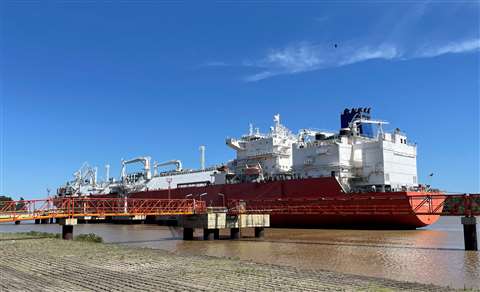European LNG import capacity expected to grow
December 01, 2022
 A floating storage regasification unit (FSRU) that belongs to Excelerate Energy, is shown. (Photo: Reuters.)
A floating storage regasification unit (FSRU) that belongs to Excelerate Energy, is shown. (Photo: Reuters.)
The capacity to import LNG into Europe and the UK is expected to climb by more than a third over the next two years, a recent study has shown.
Data from the International Group of Liquefied Natural Gas Importers (GIIGNL) shows that regasification facilities in the region will grow by a total of 5.3 Bcf/d in 2023 and another 1.5 Bcf/d in 2024.
Regasification capacity in Europe and the UK grew a relatively modest 2.8 Bcf/d, or 16% during the 10-year period prior to 2021, the group reported. Russia’s invasion of the Ukraine has led to a sudden decline in natural gas pipeline shipments to Europe and the region has looked to develop previously shelved regasification projects.
Many of these new or reactivated projects can be implemented quickly by chartering floating storage and regasification units (FSRUs) and building pipelines to move the gas to an onshore distribution network. Other projects in Europe will boost the capacity at existing onshore terminals and upgrade the throughput of existing terminals, the group said.
So far this year new and expanded LNG regasification facilities have opened in the Netherlands, Poland, Finland, Italy and Germany, boosting import capacity by a umulative 1.7 Bcf/d. A new terminal in the Netherlands has the capacity to take in 800 MMscf/d and consists of two FSRU vessels that took in the first import cargo in September. Within seven weeks, the terminal had received gas from 10 different vessels, EemsEnergy announced.
A new FSRU terminal at Germany’s Wilhelmshaven port was completed in November with a capacity of 700 MMscf/d.
Import terminals are under construction in seven EU countries. Germany is developing three new FSRU terminals, which will add a total of 1.4 Bcf/d of regasification capacity at Lubmin, Brunsbuttel and Wilhemshaven, the International Energy Agency reported. Two terminals, one at Lubmin and another at Brunsbutte, are expected to start operations this winter. A second terminal at Wilhelmshaven is expected to start operations in 2023.
Poland plans to expand its capacity at the existing LNG regasification terminal at Świnoujście by 200 MMscf/d for a total capacity of 800 MMscf/d by the end of 2023.
France will bring the Cape Anne FSRU to Le Havre port, boosting capacity by 400 MMcf/d by the fall of 2023. Finland and Estonia are jointly developing an FSRU terminal in the Finnish port of INkoo, which is scheduled to come online this winter with a capacity of 500 MMcf/d.
Italy is developing an FSRU terminal near the port of Piombino with a capacity of 500 MMcf/d. Greece will bring an FSRU to the port of Alexandoupolis by the end of 2023, boosting import capacity by another 500 MMcf/d.
MAGAZINE
NEWSLETTER

CONNECT WITH THE TEAM








